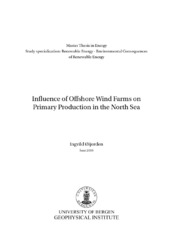Influence of Offshore Wind Farms on Primary Production in the North Sea
Master thesis
Permanent lenke
https://hdl.handle.net/1956/12618Utgivelsesdato
2016-06-01Metadata
Vis full innførselSamlinger
- Geophysical Institute [1198]
Sammendrag
The less studied environmental consequences of power production from offshore wind energy on the marine ecosystem dynamics, are studied through investigation of response on primary production. An idealized wind farm parameterization is developed based on a theoretical approach by (Brostrom, 2008), giving a two-dimensional wind stress pattern of reduced wind stress downstream of a wind farm. The method is modified to simulate a number of offshore wind farms in the North Sea with a variable wind forcing. The wind farm parameterization is developed for the well known bio-physical model ECOSMO (ECOSystem MOdel). The wind stress field forcing the model is modified by the wind farm parameterization, giving a modified wind stress field of reduced wind stress downstream of wind farms. Different model runs for year 2008, including the parameterization with different maximumwind stress deficit and for different setup of wind farms in the North Sea, are compared to a reference run. The primary producers Flagellates and Diatoms are investigated and the physical state variables temperature and salinity are used to study stratification andmixing of the North Sea during the year. The wind farmparameterization creates the desired wind stress deficit pattern from (Brostrom, 2008) for different wind speeds and directions, where larger wind farms results in a stronger and wider wake. Modelled annual total primary production in the North Sea for year 2008 is only weakly effected by wind farm implementation by a few percent increase in production. However greater geographical variations in primary production are found. Both areas of increased and decreased production due to wind farm implementation in the North Sea are found for daily, monthly and yearly means, of order 80 % change in production. The large geographical change in distribution of primary production is expected to effect higher trophic levels.
